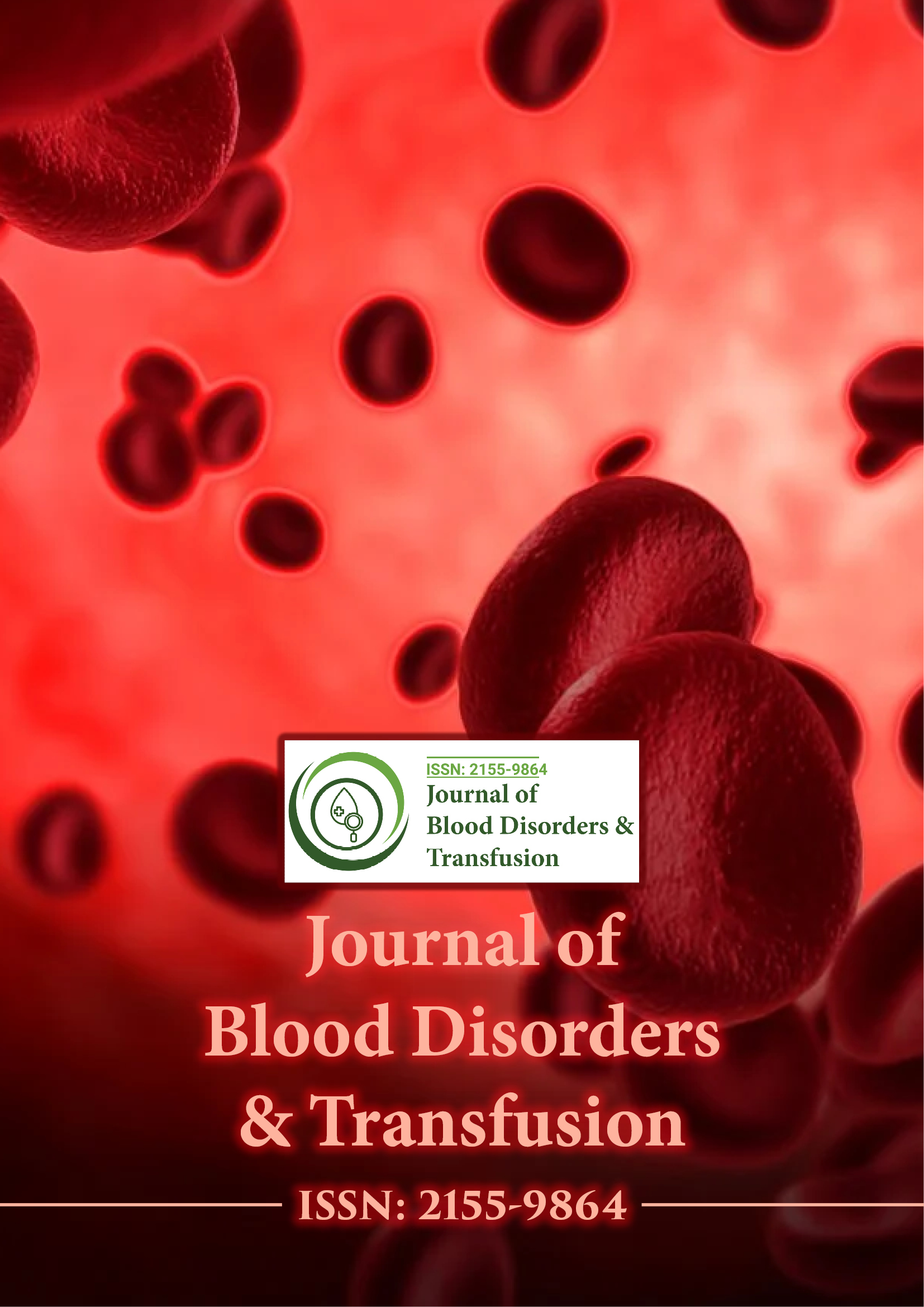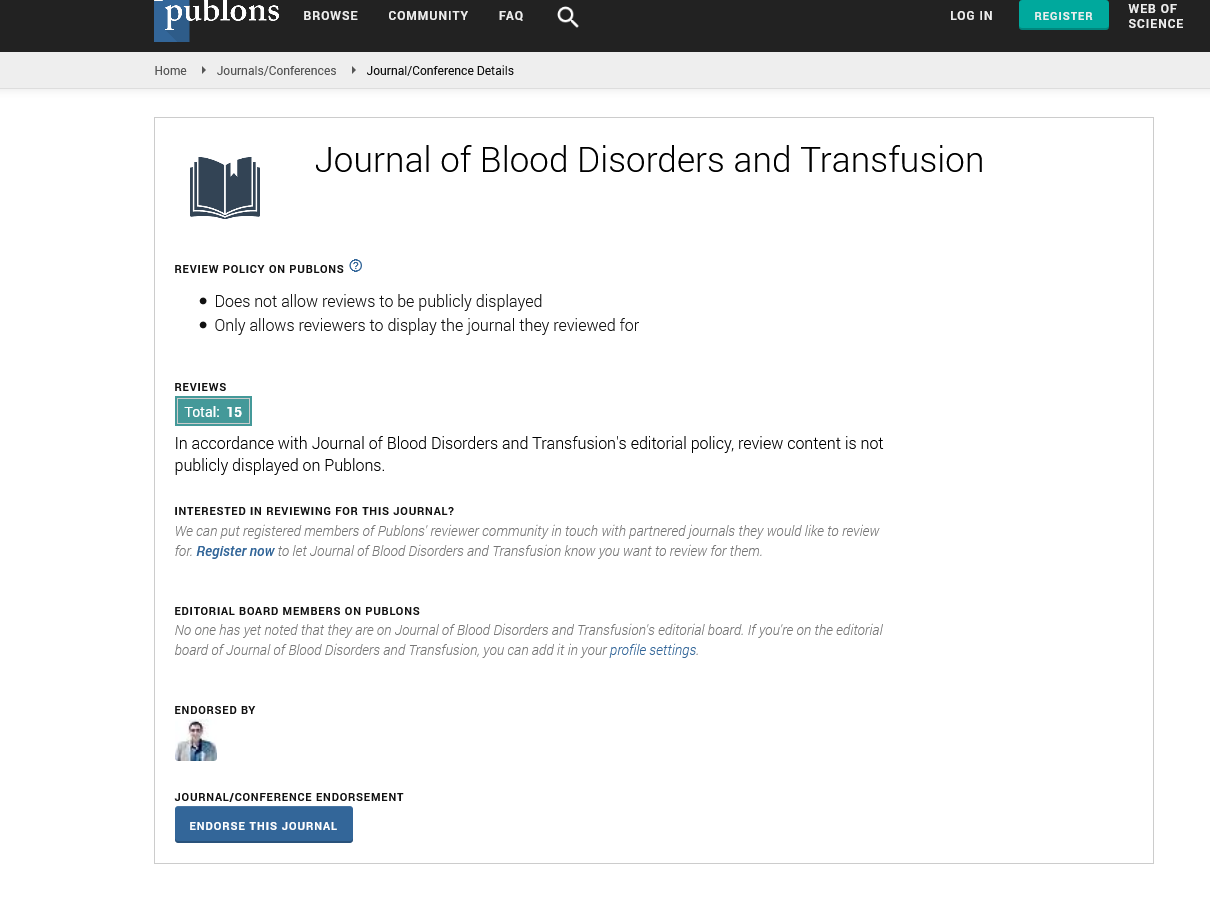Indexed In
- Open J Gate
- Genamics JournalSeek
- JournalTOCs
- Ulrich's Periodicals Directory
- RefSeek
- Hamdard University
- EBSCO A-Z
- OCLC- WorldCat
- Proquest Summons
- Publons
- Geneva Foundation for Medical Education and Research
- Euro Pub
- Google Scholar
Useful Links
Share This Page
Journal Flyer

Open Access Journals
- Agri and Aquaculture
- Biochemistry
- Bioinformatics & Systems Biology
- Business & Management
- Chemistry
- Clinical Sciences
- Engineering
- Food & Nutrition
- General Science
- Genetics & Molecular Biology
- Immunology & Microbiology
- Medical Sciences
- Neuroscience & Psychology
- Nursing & Health Care
- Pharmaceutical Sciences
Short Communication - (2024) Volume 0, Issue 0
Modern Techniques in Hematopoietic Stem Cell Transplantation: Advancing Donor Matching and Genomic Profiling
Bertson Perez*Received: 26-Jul-2024, Manuscript No. JBDT-24-26839; Editor assigned: 30-Jul-2024, Pre QC No. JBDT-24-26839 (PQ); Reviewed: 14-Aug-2024, QC No. JBDT-24-26839; Revised: 21-Aug-2024, Manuscript No. JBDT-24-26839 (R); Published: 29-Aug-2024, DOI: 10.4172/2155-9864.24.S10.047
Description
Coagulation Hematopoietic Stem Cell Transplantation (HSCT) has revolutionized the treatment of various hematological neoplasms, offering hope to patients with other limited options. This advanced therapeutic procedure involves the transplantation of multipotent hematopoietic stem cells, which are capable of developing into all types of blood cells. These stem cells can be sourced from bone marrow, peripheral blood, or umbilical cord blood. The effectiveness of hematopoietic stem cell transplantation is evident in its ability to replace diseased or damaged bone marrow with healthy stem cells. This not only restores normal blood cell production but also enhances the patient's immune system. Innovations in HSCT have significantly improved patient outcomes, making it a cornerstone in hematological neoplasm treatment. Hematopoietic stem cell transplantation is particularly beneficial in treating conditions such as leukemia, lymphoma, and multiple myeloma. The introduction of more precise conditioning regimens, better donor matching techniques, and supportive care strategies has led to higher survival rates and fewer complications [1-4].
Hematopoietic stem cell transplantation can be categorized into two main types and the hematopoietic is autologous and allogeneic transplants. In autologous transplants, patients receive their own stem cells, harvested prior to intensive therapy. Allogeneic transplants involve stem cells sourced from a compatible donor, which may be a sibling or an unrelated donor from a stem cell registry. Each type has its indications, benefits, and risks, tailored to the patient's specific condition [5-7].
Innovations in hematopoietic stem cell transplantation have significantly improved patient outcomes. Techniques such as reduced-intensity conditioning regimens, novel immuno-suppressive therapies, and the use of haploidentical donors have expanded the eligibility for transplant and reduced associated morbidity and mortality. Additionally, advancements in genomic profiling enable personalized treatment plans, enhancing the efficacy of hematopoietic stem cell transplantation. Hematopoietic stem cell transplantation has witnessed significant progress over the past few years. These advancements are pivotal in improving patient outcomes, reducing complications, and expanding the applicability of transplantation in treating hematological neoplasms. Innovations in hematopoietic stem cell transplantation begin with the harvesting process. Modern techniques such as mobilized Peripheral Blood Stem Cell (PBSC) collection and the use of growth factors like G-CSF (Granulocyte-Colony Stimulating Factor) have enhanced stem cell yield and patient comfort. This approach not only shortens hospital stay but also mitigates the risks associated with traditional bone marrow extraction [8].
Enhanced Conditioning regimens have also evolved, now including Reduced-Intensity Conditioning (RIC) and Non- Myeloablative Conditioning (NMAC) protocols. These new methodologies are less toxic compared to conventional myeloablative conditioning, making hematopoietic stem cell transplantation accessible to older patients and those with comorbidities. This broadens the candidate pool for transplantation and improves overall survival rates. The success of hematopoietic stem cell transplantation heavily relies on donor matching. Enhanced techniques in HLA (human leukocyte antigen) typing and the utilization of haploidentical donors have substantially increased the chances of finding suitable donors. High-resolution HLA typing and the use of post-transplant cyclophosphamide help reduce graft-versus-host disease, ensuring better patient outcomes. Post-transplant care has seen innovations with the advent of advanced immunosuppressive therapies and targeted treatments aimed at reducing relapse and infections. Regular monitoring using Next-Generation Sequencing (NGS) for Minimal Residual Disease (MRD) allows early intervention, thereby improving long-term results for patients undergoing hematopoietic stem cell transplantation.
Personalized medicine is introduce in hematopoietic stem cell transplantation. Tailoring conditioning regimens, donor selection, and post-transplant care to the individual genetic profile of the patient ensures higher efficacy and fewer complications. This approach leverages genomic data to customize every aspect of the transplantation process. In conclusion, the landscape of hematopoietic stem cell transplant- ation is continually evolving with new techniques that improve efficiency, safety, and accessibility. These advancements are important for enhancing the prognosis for patients with hematological neoplasms, making hematopoietic stem cell transplantation a cornerstone in modern hematology [9].
Hematopoietic stem cell transplantation has revolutionized the treatment of hematological neoplasms. One of the critical aspects of this procedure is the pre-transplant conditioning regimen, which prepares the patient's body to accept the new stem cells. Recent innovations in conditioning regimens have significantly improved patient outcomes and reduced complications. Reduced- Intensity Conditioning (RIC) has emerged as a promising alternative to traditional high-dose chemotherapy. RIC regimens use lower doses of chemotherapy and radiation, which are less toxic and better tolerated by older patients or those with comorbid conditions. This innovation in hematopoietic stem cell transplantation has expanded the eligibility criteria, allowing more patients to benefit from the procedure. The integration of targeted therapies into conditioning regimens represents another significant advancement. Drugs that specifically target cancer cells can be combined with traditional chemotherapy to enhance the efficacy of the conditioning process. This approach not only improves the eradication of malignant cells but also spares normal tissues, thereby reducing side effects and improving overall transplant success rates. Immunotherapy based conditioning regimens are reshaping the landscape of hematopoietic stem cell transplantation. These regimens employ immune checkpoint inhibitors and other immunomodulatory agents to enhance the body's immune response against cancer cells. The use of immunotherapy in conditioning has shown promising results in increasing the effectiveness of the transplant and reducing the risk of relapse. Radiation-free conditioning regimens are gaining traction as a viable alternative for preparing patients for hematopoietic stem cell transplantation. These regimens rely solely on chemotherapy and immunotherapy agents, eliminating the need for total body irradiation. This innovation reduces the long-term side effects associated with radiation, such as secondary cancers and organ damage, thereby improving the quality of life for transplant recipients [10].
Advances in genomic and molecular profiling have introduced for personalized conditioning regimens. By tailoring the conditioning protocol to the individual patient's genetic makeup and disease characteristics, clinicians can optimize the treatment's efficacy and minimize adverse effects. Personalized regimens represent a significant leap forward in the field of hematopoietic stem cell transplantation, offering a more precise and effective approach to treatment. In conclusion, the field of hematopoietic stem cell transplantation is continually evolving, with innovations in pre-transplant conditioning regimens leading the way. These advancements are not only enhancing the success rates of transplants but also improving patient outcomes and quality of life. As research progresses, we can expect even more breakthroughs in the conditioning protocols, further solidifying hematopoietic stem cell transplantation as a cornerstone in the treatment of hematological neoplasms.
References
- Hatzimichael E, Tuthill M. Hematopoietic stem cell transplantation. Stem Cells Cloning. 2010:105-117.
[Crossref] [Google Scholar] [PubMed]
- Clark JR, Scott SD, Jack AL. Monitoring of chimerism following allogeneic haematopoietic stem cell transplantation (HSCT): technical recommendations for the use of short tandem repeat (STR) based techniques, on behalf of the United Kingdom National External Quality Assessment Service for Leucocyte Immunophenotyping Chimerism Working Group. Br J Haematol. 2015; 168(1):26-37.
[Crossref] [Google Scholar] [PubMed]
- Geo JA, Ameen R, Al Shemmari S, Thomas J. Advancements in HLA Typing Techniques and Their Impact on Transplantation Medicine. Med Princ Pract. 2024; 33(3):215-231.
[Crossref] [Google Scholar] [PubMed]
- Daher-Reyes G, Kim T. Prognostic impact of the adverse molecular-genetic profile on long-term outcomes following allogeneic hematopoietic stem cell transplantation in acute myeloid leukemia. Bone Marrow Transplant. 2021;56(8):1908-1918.
[Crossref] [Google Scholar] [PubMed]
- Wong WH, Bhatt S, Trinkaus K. Engraftment of rare, pathogenic donor hematopoietic mutations in unrelated hematopoietic stem cell transplantation. Sci Transl Med. 2020;12(526):eaax6249.
[Crossref] [Google Scholar] [PubMed]
- Cheng AP, Cheng MP. Cell-free DNA profiling informs all major complications of hematopoietic cell transplantation. Proc Natl Acad Sci U S A. 2022; 119(4):e2113476118.
[Crossref] [Google Scholar] [PubMed]
- Lewis J, Greenway SC. Assessment of donor cell engraftment after hematopoietic stem cell transplantation for sickle cell disease: A review of current and future methods. Am J Hematol. 2022; 97(10):1359-1371.
[Crossref] [Google Scholar] [PubMed]
- Anand A, Diaz Burlinson N. BSHI guideline: HLA matching and donor selection for haematopoietic progenitor cell transplantation. Int J Immunogenet. 2021 Apr;48(2):75-109.
[Crossref] [Google Scholar] [PubMed]
- McKay R. Stem cells in the central nervous system. Science. 1997; 276(5309):66-71.
[Crossref] [Google Scholar] [PubMed]
- Lo Sardo V, Ferguson W. Influence of donor age on induced pluripotent stem cells. Nat Biotechnol. 2017 Jan;35(1):69-74.
[Crossref] [Google Scholar] [PubMed]
Citation: Perez B (2024). Modern Techniques in Hematopoietic Stem Cell Transplantation: Advancing Donor Matching and Genomic Profiling. J Blood Disord Transfus. S10:047.
Copyright: © 2024 Perez B. This is an open-access article distributed under the terms of the Creative Commons Attribution License, which permits unrestricted use, distribution, and reproduction in any medium, provided the original author and source are credited.

